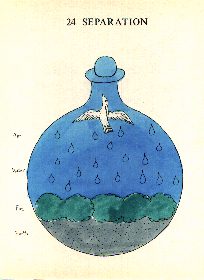













The Alchemy web site on Levity.com
The Crowning of Nature
Text and figures 18-27.Back to Crowning of Nature main page . Go to next section

The Separation of the Elements
Therefore the separation of the elements in this art is nothing else than to separate or segregate heterogeneous (which are accidents from homogeneous (which are of the Essence of the Stone), that at length the mixture of the elements might be most pure and perfect. But the conjunction of the elements is to keep up homogeneous things, that is, those that are of the nature of the Radical Moisture.
Hence Raymond "have patience in dealbation or whitening, because here lieth much tardity".
Thou must know further, my Son, that the separation of the elements with the Philosophers is termed the conversion of them, as if to convert the elements was to make a thin body of a gross one, that is, of the body a spirit, and afterwards of the moist a dry, of water earth, and the elements are converted one into the other. But the Philosophers do prescribe such a manner of converting the body into the spirit. The earth is resolved into water, and water into air, the air into fire, but the spirit is turned into the body. This way the fire is coagulated and it becomes air, but the air is coagulated and becomes water, but the water is coagulated and becomes earth.
From whence saith Assidnus "behold elements hath met together in one nature, who when they are so impelled (that is coagulated) become friends, but when they wax thin they become enemies. Therefore convert the elements and thou shalt find what thou seeketh".
It behovest thee, therefore, first of all to mortify and exalt the Stone, that is, the body, soul and spirit, seeing that no one gains any thing in this art except he mortifieth, but mortification is by the separation of the elements, by which the effect of every element is shown.
Therefore if thou wilt make the elixir, it will be necessary that thou break this Stone into his elements, which is signified by the parts of the year, and then conjoin the elements by fire, Mercury mediating, which is the Philosopher's chiefest secret, and then this Mystery is completed, for all the art is placed in conjoining and loosing. But these separations are done as seest, my Son, Mercury mediating, for it first looseth the body and makes separation which in the meantime are conjoined by Salt and Mercury.
But here we must diligently note it is first of all Mercury,in the beginning of the work is called water, then the blackness appearing earth, then being sublimated air, and being made red is called fire.

The Conjunction of the Elements
Then being added to the whole composed matter it is called the Spirit. And so the Earth, with Water, Air and Fire, is a body, the Salt is the life, the last watering of the only Mercury, the spirit.
It is therefore evident that the Stone consisteth of four elements, to wit, Water, Air, Fire and Earth. For in the Stone there are the Soul, the Body and Spirit, and yet but one Stone, as it is above said, behoving to loose and coagulate him again, then all the operations are contained under the Solution until the Albifaction it is sodden again, and becomes a Stone again when it is coagulated. Afterwards it is loosed again and then the solution is reiterated, until the Stone comes out like wax.








If you have problems understanding these alchemical texts, Adam McLean now provides a study course entitled How to read alchemical texts : a guide for the perplexed.
16th Century
Practical alchemy
Philosophical alchemy
17th Century
Practical alchemy
Philosophical alchemy
18th Century
Practical alchemy
Philosophical alchemy
Alchemical poetry
Alchemical allegories
Works of Nicolas Flamel
Works of George Ripley
Works of Sendivogius
Theatrum Chemicum Britannicum
Emerald tablet of Hermes
Rosicrucian texts
Literary works
Texts from Musaeum Hermeticum
Spanish alchemical texts
German alchemical texts
French alchemical texts
Russian alchemical texts
Italian alchemical texts
